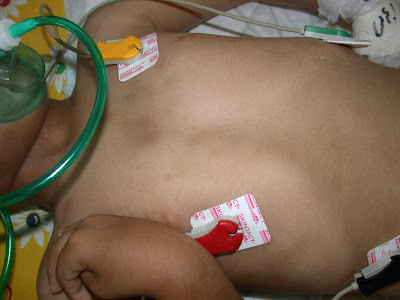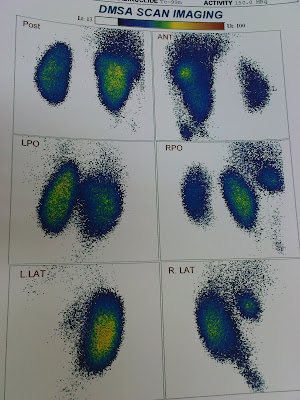Clinical features and diagnosis of urinary tract infections in children

In a meta-analysis of the diagnostic accuracy of the symptoms and signs of UTI in children younger than two years, the following symptoms and signs were the most helpful in identifying children with UTI
- History of UTI (LR 2.3)
- Temperature >40ºC (LR 3.2)
- Suprapubic tenderness (LR 4.4)
- Lack of circumcision (LR 2.8)
- Temperature >39ºC for 48 hours in absence of another source for fever (LR 4.0)
- Temperature <39ºc,>
Fever
- Infants and children younger than 2 years can present with fever as the sole manifestation
- The prevalence of UTI is greater among infants and young children with maximum temperatures 39ºC than in those with lesser degrees of fever
- The presence of another potential source of fever (upper respiratory tract infection, acute otitis media, acute gastroenteritis) does not rule out the possibility of UTI
Other symptoms
Less common symptoms of UTI in infants include:
- Conjugated hyperbilirubinemia (in those <28>
- Irritability
- Poor feeding
- Failure to thrive
Parental reporting of foul-smelling urine or the presence of gastrointestinal symptoms (vomiting, diarrhea, and poor feeding) does not correlate with UTI
Older children
Symptoms of UTI in older children may include:
- Fever
- Urinary symptoms (dysuria, urgency, frequency, incontinence, macroscopic hematuria)
- Abdominal pain
The constellation of fever, chills, and flank pain is suggestive of pyelonephritis in older children
Occasionally, older children may present with:
- Short stature
- Poor weight gain
- Hypertension secondary to renal scarring from unrecognized UTI earlier in childhood
- Suprapubic tenderness and CVA tenderness may be present on examination of older children with UTI.
- Abdominal pain (LR 6.3)
- Back pain (LR 3.6)
- Dysuria, frequency, or both (LR 2.2)
- New onset urinary incontinence (LR 4.6)
- Height and duration of fever
- Urinary symptoms (dysuria, frequency, urgency, incontinence)
- Abdominal pain
- Suprapubic discomfort
- Back pain
- Vomiting
- Recent illnesses
- Antibiotics administered
- Sexual activity (if applicable)
Past medical history should include:
- Chronic urinary symptoms (Incontinence, lack of proper stream, frequency, urgency)
- Chronic constipation
- Previous UTI
- Vesicoureteral reflux (VUR)
- Previous undiagnosed febrile illnesses
- Family history of frequent UTI, VUR, and other genitourinary abnormalities
- Antenatally diagnosed renal abnormality
- Elevated blood pressure
- Poor growth
Physical examination
Important aspects of the physical examination in the child with suspected UTI include:
- Documentation of blood pressure and temperature.
- Growth parameters (poor weight gain and/or failure to thrive may be an indication of chronic or recurrent UTI).
- Abdominal examination for tenderness or mass (eg, enlarged bladder or enlarged kidney secondary to urinary obstruction).
- Assessment of suprapubic and costovertebral tenderness.
- Examination of the external genitalia for anatomic abnormalities.
- Evaluation of the lower back for signs of occult myelodysplasia (e.g., midline pigmentation, lipoma, vascular lesion, sinus, tuft of hair), which may be associated with a neurogenic bladder.
- Evaluation for other sources of fever.
LABORATORY EVALUATION
We recommend that urine samples be obtained for urinalysis (dipstick and microscopic examination) and culture in the following patients:
- Girls and uncircumcised boys younger than two years with at least one risk factor for UTI (history of UTI, temperature >39ºC, fever without apparent source, ill appearance, suprapubic tenderness, fever >24 hours or nonblack race).
- Circumcised boys younger than two years with suprapubic tenderness or at least two risk factors for UTI.
- Girls and uncircumcised boys older than two years with any of the following urinary symptoms (abdominal pain, back pain, dysuria, frequency, high fever, or new-onset incontinence).
- Circumcised boys older than two years with multiple urinary symptoms (abdominal pain, back pain, dysuria, frequency, high fever, or new-onset incontinence).
Febrile infants and children with a abnormalities of the urinary tract, or family history of urinary tract disease.A different analysis highlighted the following risk factors:
Age younger than 1 year
White race
Temperature 39ºC
Fever for more than two days
Absence of another source of fever on history or examination (ie, absence of upper respiratory infection, acute otitis media, gastroenteritis)
Urine culture is the gold standard for the diagnosis of UTI. We suggest that urine culture be performed in the following groups, even if the dipstick and microscopic analysis are negative:
- Girls and uncircumcised boys younger than two years with at least one risk factor for UTI (history of UTI, temperature >39ºC, fever without apparent source, ill appearance, suprapubic tenderness, fever >24 hours or nonblack race).
- Circumcised boys younger than two years with suprapubic tenderness or at least two risk factors for UTI.
- Girls and uncircumcised boys older than two years with any of the following urinary or abdominal symptoms (abdominal pain, back pain, dysuria, frequency, high fever, or new-onset incontinence).
- Circumcised boys older than two years with multiple urinary symptoms (abdominal pain, back pain, dysuria, frequency, high fever, or new-onset incontinence).
Febrile infants and children with a abnormalities of the urinary tract, or family history of urinary tract disease. - Infants and children who will be presumptively treated with antibiotics.
Elevated peripheral white blood cell (WBC), erythrocyte sedimentation rate (ESR), and C-reactive protein (CRP) are indicators of an acute inflammatory process, but are not helpful in predicting UTI
In addition, though more sensitive than WBC and ESR, CRP does not reliably differentiate between cystitis and pyelonephritis (approximately 30 percent of children with a normal CRP have pyelonephritis)
Infants <1>
Clean catch sample — We define significant bacteriuria from a clean catch urine specimen in children as growth of 100,000 colony forming units (CFU)/mL of a single uropathogenic bacteria. This is the same as the standard definition for significant bacteriuria on clean catch specimens in adults, which is based upon studies from the 1950s.
Catheter sample — We define significant bacteriuria from catheterized specimens in children as growth of 50,000 CFU/mL of a single uropathogenic bacteria. (the American Academy of Pediatrics considers growth of 10,000 CFU/mL of a single pathogen as significant)
However, in a prospective study of febrile children <24>
Suprapubic sample — We define significant bacteriuria from suprapubic aspiration specimens as the growth of any uropathogenic bacteria (The American Academy of Pediatrics practice parameter considers the growth of any gram-negative uropathogen from a suprapubic specimen significant, but requires more than a few thousand CFU/mL for gram-positive pathogens)
Labels: pediatrics





















